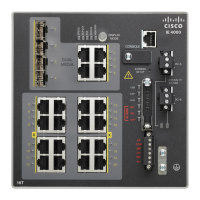669
Cisco Systems, Inc. www.cisco.com
Configuring Link State Tracking
Restrictions for Configuring Link State Tracking
To use this feature, the switch must be running the LAN Base image.
An interface that is defined as an upstream interface cannot also be defined as a downstream interface in the same
or a different link state group. The reverse is also true.
An interface cannot be a member of more than one link state group.
You can configure only two link state groups per switch.
Information About Configuring Link State Tracking
Link State Tracking
Link state tracking, also known as trunk failover, is a feature that binds the link state of multiple interfaces. For example,
link state tracking provides redundancy in the network when used with server NIC adapter teaming. When the server
network adapters are configured in a primary or secondary relationship known as teaming, if the link is lost on the primary
interface, connectivity is transparently changed to the secondary interface.
Note: An interface can be an aggregation of ports (an EtherChannel), a single physical port in access or trunk mode, or
a routed port.
Figure 85 on page 671 shows a network configured with link state tracking. To enable link state tracking, create a link
state group, and specify the interfaces that are assigned to the link state group. In a link state group, these interfaces are
bundled together. The downstream interfaces are bound to the upstream interfaces. Interfaces connected to servers are
referred to as downstream interfaces, and interfaces connected to distribution switches and network devices are referred
to as upstream interfaces.
The configuration in Figure 85 on page 671 ensures that the network traffic flow is balanced as follows:
For links to switches and other network devices
— Server 1 and server 2 use switch A for primary links and switch B for secondary links.
— Server 3 and server 4 use switch B for primary links and switch A for secondary links.
Link state group 1 on switch A
— Switch A provides primary links to server 1 and server 2 through link state group 1. Port 1 is connected to
server 1, and port 2 is connected to server 2. Port 1 and port 2 are the downstream interfaces in link state group
1.
— Port 5 and port 6 are connected to distribution switch 1 through link state group 1. Port 5 and port 6 are the
upstream interfaces in link state group 1.

